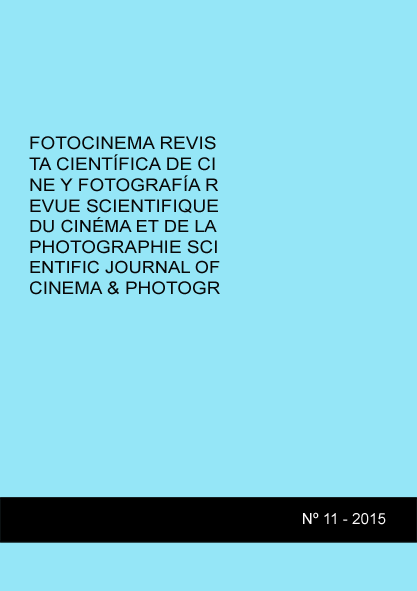Cuando el horizonte es el presente. El tiempo en suspensión en la obra de Chien-Chi Chang
DOI:
https://doi.org/10.24310/Fotocinema.2015.v0i11.6079Abstract
Los conceptos de alteridad y mismidad, presentes en la filosofía desde sus orígenes, se han convertido en debate relevante desde la segunda mitad del siglo XX. Cuestiones como la representación del Otro, la autorreferencialidad o la construcción hegemónica de los regímenes historicistas han copado los estudios postcoloniales.
Ahora bien, dicha dicotomía alteridad-mismidad es puesta en entredicho en la actualidad por las identidades fluidas provocadas por los flujos migratorios. A través de la serie “I do, I do, I do” del fotógrafo Chien-Chi Chang, miembro de la agencia Magnum, el presente artículo pretende teorizar sobre la hibridación de los conceptos de alteridad y mismidad a través de una nueva conceptualización de la temporalidad.
Abstract:
The concepts of otherness and sameness, present in philosophy since its origin, have been a subject of controversy since the mid-twentieth century. Issues such as the representation of the Other, the autorreferenciality and the historicity have ruled postcolonial studies.
But this dichotomy sameness-otherness is put in question today by fluid identities caused by migration. Through the analysis of "I do, I do, I do", a photography serie taken by Chien-Chi Chang, a member of Magnum Agency, the paper aims to hybridize the concepts of otherness and sameness through a new conceptualization of temporality.
Palabras clave:
Altermodernidad; heterocronía; Chien-Chi Chang; fotografía china contemporánea; alteridad.
Keywords:
Altermodernity; Heterochrony; Chien-Chien Chang; Contemporary Chinese Photography; Alterity.
Downloads
Metrics
Downloads
Published
How to Cite
Issue
Section
License
All contents published in Fotocinema Revista científica de cine y fotografía are protected under the Creative Commons Attribution-NonCommercial-ShareAlike 4.0 International (CC BY-NC-SA 4.0) license. All about this license is available in the following link: <http://creativecommons.org/licenses/by-nc-sa/4.0>
Users can copy, use, redistribute, share and exhibit publicly as long as:
- The original source and authorship of the material are cited (Journal, Publisher and URL of the work).
- It is not used for comercial purposes.
- The existence of the license and its especifications are mentioned.
There are two sets of authors’ rights: moral and property rights. Moral rights are perpetual prerogatives, unrenounceable, not-transferable, unalienable, imprescriptible and inembargable. According to authors’ rights legislation, Fotocinema. Revista científica de cine y fotografía recognizes and respects authors moral rights, as well as the ownership of property rights, which will be transferred to University of Malaga in open access. The property rights are referred to the benefits that are gained by the use or the dissemination of works. Fotocinema. Revista científica de cine y fotografía is published in an open access form and it is exclusively licenced by any means for doing or authorising distribution, dissemination, reproduction, , adaptation, translation or arrangement of works.
Authors are responsable for obtaining the necessary permission to use copyrighted images.













13.png)




